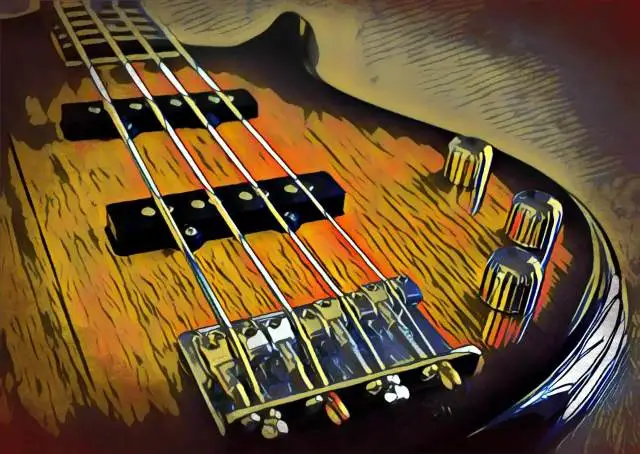The bass line is one of the most important elements of any song: it establishes rhythm, key, and creates a cohesive canvas for the rest of the instruments and vocal parts. That being said, creating effective yet memorable bass lines can be understandably intimidating for those new to music production.
Fortunately, we've crafted a comprehensive guide on how to write bass lines like pro musicians. Whether you're into electronic music or rock standards, we'll outline the basic principles of bass below.
Understanding the Role of the Bass Guitar
The bass guitar plays a more important role in music production than you might expect-- it's one of the few instruments that primarily occupies the lower frequency range, making it noticeable and blend into the background of the beat all at once.
Your bass guitar or MIDI bass line helps establish the key of a song as well as rhythm, making it integral to the landscape of your production. It's also unique in that it often holds a similar space as the drums, which is why it's so common to use sidechain compression on your bass line in response to drums.
Bass lines are typically played one note at a time and can be somewhat repetitive, but they are the stable foundation that allows the rest of a track's instrumentation to grow and develop over the course of the song.
What Do I Need to Start Writing Bass Lines?
In the age of electronic music, you don't necessarily need a bass guitar to write a killer bass line. While having bass guitar background is helpful in terms of understanding the rhythmic and foundational role of the bass line, you can create bass lines in your DAW utilizing a MIDI keyboard within your piano roll or MIDI clip.
Technically speaking, this is all you need to start writing bass lines, but it will help you immensely if you have a basic understanding of music theory and keys. In most cases, you'll be playing one note at a time when performing a bass line. The notes played are typically within the key of the song your in, and often revolve around the strongest scale degrees or 1, 3, and 5.
What exactly does that mean? Well, let's take a look at the key of C Major. The C Major Scale consists of C D E F G A B, without any sharps are flat. You can expect a bass line to often include the notes C E G within the key of C Major since these notes have the strongest relationship to the key itself, and help establish the tone of the song.
As showcased below, it's fairly common for bass lines to start or end on the root note of the scale, or in this case "C" (this is also referred to as the tonic or the first scale degree.) With a basic understanding of this foundational music theory concept and a MIDI keyboard or bass guitar, you'll be armed with everything you need to start writing groovy bass lines.

How to Write Bass Lines in 5 Steps
Without further ado, here is your bass blueprint for writing amazing riffs and bass lines that gel perfectly with your composition:
Identify the Root Note
To start, you'll want to figure out the key of your composition as well as the root note of your key. Oftentimes, the first note of your bass line is the same note that establishes the key of your song. For instance, a bass line in a B major scale is likely to start in B, a C major bass line is likely to start in C.
You can experiment with starting your bas line on other scale degrees as depicted in the above section: for instance, it's also common to start a bass line or section with the perfect fifth or major third scale degree. Once you identify the key of your song, you can start to play with these various possibilities and see what sounds good to you.
You can identify your key by taking a look at the notes played in your song and counting sharps and flats to identify using the circle of fifths. If you're still getting your bearings, you can use a site like Vocal Remover to analyze your track and give you the ballpark of what key you might be in.
Consider Your Chord Progression
Whenever you're writing bass lines, it's important to keep the context of the full chord progression in context. In many cases, your bass line will speak to one of the major components of your chord-- either the first, third, or fifth scale degrees. Let's say one measure of music is focused around a C major chord: if your lead guitar is focused around G (the fifth), other elements are iterating the E (the third), then your bass can help complete the chord by playing a C or the tonic.
Your bass note doesn't necessarily have to be the root note for each chord-- in many cases, the bass line will play other notes of the chord, otherwise known as a chord inversion. The key takeaway is be mindful of what the other instruments and sounds in your mix are emphasizing and adjust your bass line accordingly.
Switching Up the Rhythm
Once you have a good idea of what notes you want to use in your bass line, enjoy playing with rhythm. This could be as simple as switching up the bass note every measure, or every 4 counts in most cases. You can experiment with different note lengths, moving between quarter notes, and eighth notes-- it's all up to taste. If you don't know where to start, opt for the root note on the one of the beat. This will help you firmly establish the key and can serve as a great foundation for the rest of your riff.
Consider Some Syncopation
Once you get a bit more comfortable writing different types of bass lines, you might find yourself interested in experimenting with syncopation, or playing notes off beat, or between the beat with some level of structure. Playing notes slightly off beat or utilizing syncopation can create some of the grooviness most bass lines are known for.
Add Variation Over Time
After you've played with the rhythm and the basic structure of your bass line, consider creating different sections over the course of the song where you shift notes, rhythmic patterns, or the particular instrument or tone of your bass line. Adding variation, even if it's just a small swap at the end of four or eight bars can help keep your listeners engaged.
Layer the Bass Sound, Sub Bass, and Balance
The bass line is undoubtedly one of the most important components of a track, but since it resides in the low-frequency range, it can have the tendency to overpower the rest of the musical elements if the volume balance is off. It's important to EQ and cater the bass according to the needs of your track.
For instance, it's not uncommon to use a low pass filter on your bass line, mitigating any unnecessary higher frequencies that could be clouding up the rest of your mix. You might also layer your main bass line with a sub bass line to create a cleaner low end, as sub basses are designed to be fairly simple, sometimes acting as an isolated sine wave.
Creating this balance between the sub bass, bass, and the rest of the instruments will ensure that your bass line is able to shine as needed without overpowering the rest of the mix.
How to Write Bass Lines FAQ
Are you ready to lay down some groovy bass lines? Here are a couple of commonly asked questions and answers to consider:
How do you write basslines for a song?
We detail exactly how to write bass lines for songs above, but it essentially boils down to playing notes within the key of your song and adding rhythmic variation. Play notes that help establish the key and create a foundation for the other layers within your song.
What makes a bass line catchy?
A bass line with interesting rhythmic variations or a dynamic melodic arc can be undeniably catchy. Just like a vocal melody, a bass line can become an earworm.
What makes a good bassline?
A good bass line gels with the rest of the components of the song and other instruments while establishing a steady or interesting rhythm. Some of the best bass lines can be as memorable as vocal melodic elements.
How do you start a bass line?
A simple bass line often starts with the root note of the key of the song. For instance, if you're in C major, you might start your bass line on a C. However, plenty of great bass lines differ from this guiding principle, so feel free to experiment within or outside the bounds of the set key.
How do you improvise a bass line?
You can improvise a bass line across any genre whether that's rock music or dance music by playing within the key of the song. Once you feel comfortable playing notes within the respective key, you can start to add rhythmic variations to create a good bass line on the fly.
Bass notes are one of the most foundational components in any piece of music. Every musical layer has to work in collaboration with the bass riff and root notes of the song. It's this relationship that brings together the kick drum, main chords, and top-line melody to create memorable soundscapes. Enjoy putting these strategies to the test to craft great bass lines in your music.





